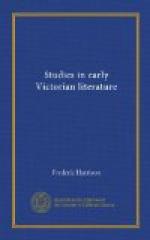We come, then, to this, that for the first time during this whole century now ending, English literature can count no living novelist whom the world, and not merely the esoteric circle of cultured Englishmen, consents to stamp with the mark of accepted fame. One is too eccentric, obscure, and subtle, another too local and equal, a third too sketchy, this one too unreal, that one far too real, too obvious, too prosaic, to win and to hold the great public by their spell. Critics praise them, friends utter rhapsodies, good judges enjoy them—but their fame is partial, local, sectional, compared to the fame of Scott, Dickens, or Thackeray.
What is the cause? I do not hesitate to say it is that we have over-trained our taste, we are overdone with criticism, we are too systematically drilled, there is far too much moderate literature and far too fastidious a standard in literature. Everyone is afraid to let himself go, to offend the conventions, or to raise a sneer. It is the inevitable result of uniformity in education and discipline in mental training. Millions can write good grammar, easy and accurate sentences, and imitate the best examples of the age. Education has been driven at high pressure into literary lines, and a monotonous correctness in literary taste has been erected into a moral code. Tens of thousands of us can put the finger on a bit of exaggeration, or a false light in the local colour, or a slip in perfect realism. The result is a photographic accuracy of detail, a barren monotony of commonplace, and the cramping of real inventive genius. It is the penalty of giving ourselves up to mechanical culture.
If another Dickens were to break out to-morrow with the riotous tomfoolery of Pickwick at the trial, or of Weller and Stiggins, a thousand lucid criticisms would denounce it as vulgar balderdash. Glaucus and Nydia at Pompeii would be called melodramatic rant. The House of the Seven Gables would be rejected by a sixpenny magazine, and Jane Eyre would not rise above a common “shocker.” Hence the enormous growth of the Kodak school of romance—the snap-shots at everyday realism with a hand camera. We know how it is done. A woman of forty, stout, plain, and dull, sits in an ordinary parlour at a tea-table, near an angular girl with a bad squint. “Some tea?” said Mary, touching the pot. “I don’t mind,” replied Jane in a careless tone; “I am rather tired and it is a dull day.” “It is,” said Mary, as her lack-lustre eyes glanced at the murky sky without. “Another cup?” And so the modern romance dribbles on hour by hour, chapter by chapter, volume by volume, recording, as in a phonograph, the minute commonplace of the average man and woman in perfectly real but entirely common situations. To this dead level of correctness literary purism has brought romance. The reaction against the photographic style, on the other hand, leads to spasmodic efforts to arouse the jaded interest by forced sensationalism, physiological bestialities, and a crude form of the hobgoblin and bogey business.




